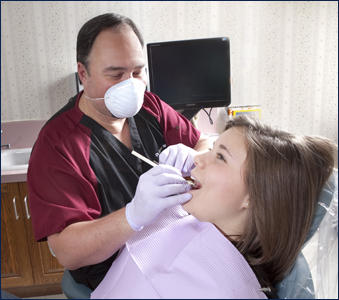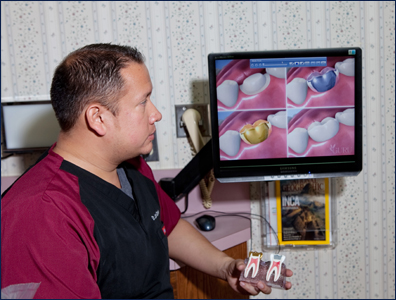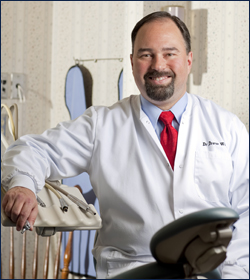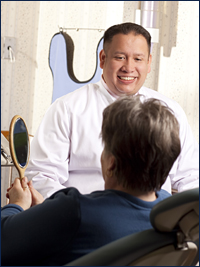|
Dental Cleaning
A dental cleaning is a professional cleaning you receive from a dentist or dental hygienist. Cleanings should be performed every six months to prevent excessive plaque buildup. Plaque left untreated can lead to unhealthy gums and tooth decay. A routine dental cleaning should include scaling and polishing.
Scaling: This is the process of removing plaque and tartar from all tooth surfaces in a variety of methods, depending on the amount of plaque and tartar.
Dental hygienists traditionally perform scaling by hand. However, new and advanced technology has lead to more modern methods such as electric scalers. This sophisticated tool allows dental cleanings to be performed more efficiently and in less time. To achieve best results, both electric and manual scaling methods are combined for dental cleanings. 
Polishing: This is the last step in tooth cleaning and involves finishing the surface of the teeth to make them shiny and clean. Rubber cup polishing uses a low-speed and gentle handpiece that contains a polishing paste made of abrasive ingredients ideal for removing stains.
Top of page
Oral Hygiene Care
Maintaining good oral hygiene is one of the most important things you can do for your teeth and gums. Healthy teeth not only enable you to look and feel good, they make it possible to eat and speak properly. Good oral health is important to your overall well-being. Daily preventive care, including proper brushing and flossing, will help stop problems before they develop. In between regular visits to the dentist, there are simple steps that each of us can take to greatly decrease the risk of developing tooth decay, gum disease and other dental problems. will help stop problems before they develop. In between regular visits to the dentist, there are simple steps that each of us can take to greatly decrease the risk of developing tooth decay, gum disease and other dental problems.
These include:
- Brush thoroughly twice a day and floss daily
- Eat a balanced diet and limit snacks between meals
- Use dental products that contain fluoride, including toothpaste
- Rinse with a fluoride mouth rinse if your dentist advises you to
- Make sure that your children under 12 drink fluoridated water or take a fluoride supplement if they live in a non-fluoridated area
- Visit your dentist regularly for professional cleanings and oral exams.
- Replace your toothbrush every 3-4 months and after illness
- The following are indications of good oral hygiene:
- Your teeth are clean and free of debris
- Gums are pink and do not hurt or bleed when you brush or floss
- Bad breath is not a constant problem
Top of page
Sealants
Sealants are used to fill in narrow grooves in a tooth that cannot be adequately cleaned by brushing. In some cases, the tooth structure has fine grooves or pits which accumulate plaque, not because the person doesn't brush, but because they're too narrow to allow even one bristle into them. These will develop cavities over time, and you don't want that. So the staff will brush on a coating that seals the grooves and pits, making it possible to brush off all the plaque and keep your teeth healthy.
Top of page
Halitosis
Halitosis is sophisticated word for “bad breath”. Depending on the cause, bad breath may strike on occasion or may be a more persistent condition. The most common cause of bad breath is bacteria. Because the mouth is moist and warm, it creates perfect conditions for the millions of bacteria that live in the mouth. In fact, approximately 80% of bad breath is caused by something in the mouth.
Bad breath caused by bacteria in the mouth can easily be treated. Brushing your teeth, tongue and gums after meals as well as flossing and rinsing with mouthwash will usually take care of the problem. Regular visits to the dentist should be made for dental examinations and for professional teeth and gum cleaning.
Some types of bad breath, such as "morning mouth," are considered fairly normal and are not usually health concerns. However, persistent bad breath may be a sign of more serious problems with the gums and teeth.
Bad breath may be caused by the following:
- Poor dental hygiene – poor oral hygiene can leave food particles to decay in the mouth
- Infections in the mouth such as periodontal (gum) disease
- Respiratory-tract infections such as throat infections, sinus infections, lung infections
- External agents including foods such as garlic, onions, and coffee, as well as cigarettes and chewing tobacco
- Dry mouth caused by salivary gland problems or by breathing through the mouth
- Systemic illnesses such as diabetes, liver disease, kidney disease, lung disease, sinus disease, reflux disease and others
Call our office promptly if you have bad breath with painful, swollen gums that bleed easily or loose teeth. We will perform a physical examination of your mouth to determine the cause. If we discover that systematic problems are the cause, we may refer you to your family physician. In severe cases of gum disease, we may recommend a doctor specialized to treat gum disease called a periodontist.
Top of page
Bonding
Bonding involves adhering composite resin material that is matched to the color of the tooth, to the front of the tooth. This is done to repair damage done to the tooth by decay, to alter the alignment of the tooth, close gaps between the teeth, or for cosmetic purposes. First the surface of the tooth is roughened in order to accept the bonding and hold it. A gel is applied to micro etch the tooth surface, and a primer/bond agent is applied so the material adheres to the surface. Then the material itself is placed on the tooth and hardened with intense light. The composite resin material is shaped and polished to get a lustrous finish as a last step.
Top of page
Fillings
A filling is a way to restore a tooth, when it has been damaged by decay, back to its normal function and shape. If you have a tooth that requires a filling, the dentist will first remove the decayed tooth material, clean the affected area, and then fill the cleaned out cavity with a filling material. A filling also helps prevent further decay by closing off any cracks or spaces where bacteria can enter.
There are a variety of filling materials available including gold, silver, plastic and porcelain. The dentist will work with you to determine which material is best for you, depending on the extent of repair, where in your mouth the filling is needed, and cost. Each of the filling materials is briefly explained below:
Amalgam (silver) fillings are a more inexpensive choice and are tolerant to wear. However, due to their dark color they are more noticeable than porcelain or composite restorations and are not recommended for fillings in very visible areas such as front teeth.
Composite (plastic) resins are custom made to the exact color of your natural teeth, creating a more natural appearance. While white fillings may be less noticeable than other materials, they usually only last between 3 and 10 years. They may not be ideal for large fillings as they may chip or wear over time. They can also become stained from coffee, tea or tobacco.
Porcelain fillings are called inlays or onlays and are custom created in a lab and then bonded to the tooth. They can be matched to the color of the tooth, resist staining, and are about the same cost as gold fillings. A porcelain restoration generally covers most of the tooth, making the filling nearly undetectable.
If decay or a fracture has damaged a large portion of the tooth, a crown, or cap, may be recommended. Decay that has reached the nerve may be treated through root canal therapy or through a procedure called pulp capping.
Top of page
Crowns and Bridges
Crowns and bridges are used to restore and enhance teeth that are damaged, or to take the place of missing teeth. A crown, also referred to as a cap, is used to entirely cover a damaged tooth. A crown not only strengthens a tooth, but it can dramatically improve a tooth’s appearance, shape and alignment.
Crowns may be used to:
- Replace a large filling when there is little tooth structure remaining
- Protect a weak tooth from fracturing
- Restore a fractured tooth
- Attach a bridge
- Cover a dental implant
- Cover a discolored or poorly shaped tooth
- Cover a tooth that has had root canal treatment
A bridge is an ideal method to fill the space created by missing teeth. A bridge is one or more artificial teeth that are cemented into place using the teeth on either side for support, hence the name. This is an option for filling the space created by a missing tooth. A bridge replaces the missing tooth, both functionally and cosmetically. Bridge work is as much an art as it is an exact science. The materials used may be gold alloys, porcelain bonded to metal alloy, or all ceramic material made to match your natural tooth color. The choice of material depends on requirements for strength, wear, and/or esthetics.
It is important that a missing tooth be replaced as soon as possible for several reasons. If not treated the teeth surrounding the gap begin to shift inward. Since teeth use their neighbors for support, if one is missing they begin to "fall” and shift into the open spaces. This may worsens the bite due to changes in pressure and can eventually result in problems with the jaw such as TMJ.
Bridges and crowns are made by first taking an impression of your mouth. The impression is sent to a dental lab where your crown or bridge will be custom made to fit your mouth and match your natural tooth color. A temporary crown or bridge will be placed into your mouth until your permanent crown or bridge is made. When the permanent crown or bridge is ready, it will be cemented into place.
Bridges and crowns are very durable and can last a lifetime with extra care and by practicing good oral hygiene.
Top of page
Wisdom Tooth Extractions
Wisdom teeth are the last molars, or “third molars” that develop on each side of the jaws. Wisdom teeth usually emerge in the back of the mouth between the ages of 16-20.
Wisdom teeth are a valuable asset to the mouth when they are healthy and properly positioned. Often, however, problems develop that require their removal. When the jaw isn't large enough to accommodate wisdom teeth, they can become impacted (unable to come in or misaligned). Wisdom teeth may grow sideways, emerge only part way through the gum or remain trapped beneath the gum and bone.
A wisdom tooth extraction is a relatively routine procedure. The dentist will numb the area in your mouth with a local anesthesia or use IV sedation so you are asleep during the procedure.
After the tooth (or teeth) is removed, you may be asked to bite down softly on a piece of gauze for 30 to 45 minutes after you leave the office, to limit any bleeding that may occur. Some pain and swelling may occur but it will normally go away after a few days; however, you should call your dentist if you have prolonged or severe pain, swelling, bleeding or fever.
Top of page
Non-Surgical Gum Treatment
The gums, ligaments, and bone around the teeth form the foundation for ones teeth. All structures are also referred to as the periodontium. When the periodontium is not healthy, it jeopardizes the teeth just as a bad foundation would threaten the stability of a house. Signs of unhealthy periodontium include: gums that are red and bleed easily, persistent bad breath, gums that are pulled away from the tooth, loose teeth, and changes in the position or bite of the teeth. Any of these may be a sign of problem. With proper gum treatments, however, it may be possible to return gum tissue to a healthy state. If you're having a problem, come in and see us so we may treat it right away. The treatment usually involves a deep cleaning or root planing done under a local anesthetic, along with local antibiotic agents. If the gum disease gets too severe it may need to be treated through surgery or extraction. This is why it is important to have it treated at the first sign of a problem.
Top of page
Root Canal Treatment
Root canal treatment (also referred to as root canal therapy or endodontic therapy) is made necessary when a cavity is allowed, through neglect, to reach all the way to the pulp. (Regular cleanings and checkups prevent and detect problems early) Sometimes deep restorations or trauma to a tooth may cause the nerve to be damaged to the point it needs root canal therapy, also. Once this occurs the pulp becomes infected, and can even extend through the root tip and begin to eat away at the surrounding bone (this is an abscess). By the time the pulp is infected it must be treated, and cannot heal on its own. It can even weaken the entire immune system. This is dangerous, not to mention very painful. Symptoms that the pulp has become infected may include sensitivity to hot/cold or sweets, pain, swelling, pain to biting or pressure, and a bad taste in the mouth. Sometimes, however, no symptoms are apparent and the person is unaware of any problem until a checkup.
A root canal is then performed to clean out the infected tooth pulp, and disinfect the canals of the tooth. The only other treatment would be to extract the tooth. Once the infection is resolved, the canal(s) are filled in to prevent any further infection. Usually a core build-up and crown is recommended for restoring a tooth that has had root canal therapy.
Top of page
TMJ Treatments
TMJ stands for temporal-mandibular joint. Temporal, as in temple area of skull; mandibular as in mandible, or lower jaw; joint as in it's where the head and jaw meet. Problems in this joint may be caused by a misalignment of the teeth, trauma, or excess muscle tension. Aside from the two bones that meet there, cartilage buffers them and five muscles are involved in the area. If something goes wrong a good deal of trouble can result.
Problems in this area can cause:
- Headaches
- Earaches
- Trouble/soreness in opening and closing the mouth
- Clicking or popping of the jaw
- Pain in the jaw muscles
- Soreness in the area, sometimes extending to the face
Dental treatments for the condition can include replacing missing teeth, moving teeth, adjusting the bite, filling gaps between teeth, etc. There is no one solution that is right for all cases. Sometimes a plastic mouthpiece is used to prevent clenching or grinding that is contributing to the problem. If untreated and taken to extremes, surgery may be required to repair a badly damaged joint.
Top of page
Nightguards and Athletic Biteguards
Custom designed mouthguards and nightguards are made of flexible plastic and molded to fit the shape of your teeth. Mouthguards are recommended to protect the jaw and teeth during physical activity and sports such as boxing, football, basketball, or other activities where your mouth may get hit. In addition, these guards protect the soft tissues of your tongue, lips and cheek lining. Nightguards are recommended for patients who clench or grind their teeth at night as a way to protect their teeth and bite.
If you have decided a guard is right for you, the dentist will take an impression of your teeth which will then be sent to a lab to make a custom fit guard for you. In most cases you can choose from a variety of colors and styles for your guard. On average, guards last between 3 and 10 years.
Top of page
Dental Implants
A dental implant is an ideal tooth restoration for people who are missing one or more teeth as a result of injury, periodontal disease, or any other reason.
 A dental implant is a metal post that a dentist surgically positions into the jaw. Once in place and bone surrounding the implant has had time to heal, a replacement tooth is attached to the post. While implants are typically more expensive than other methods of tooth replacement, they provide superior benefits. Implants are stronger than natural teeth and generally last 10-20 years. They are also a more favorable approach than bridgework since they do not depending on neighboring teeth for support. A dental implant is a metal post that a dentist surgically positions into the jaw. Once in place and bone surrounding the implant has had time to heal, a replacement tooth is attached to the post. While implants are typically more expensive than other methods of tooth replacement, they provide superior benefits. Implants are stronger than natural teeth and generally last 10-20 years. They are also a more favorable approach than bridgework since they do not depending on neighboring teeth for support.
To receive implants, you need to have healthy gums and adequate bone to support the implant. You must also be committed to excellent oral hygiene and regular dental visits as these are critical to the long-term success of dental implants.
Top of page
Dentures
A denture is a removable replacement for missing teeth and surrounding tissues. There are two types of dentures available, including partial and complete dentures. Partial dentures are used when some natural teeth remain, while complete dentures are used to completely replace all teeth. Dentures are made to resemble your natural teeth so there should be no noticeable change to your appearance. In fact, dentures may even improve your smile!
Complete Dentures
This restoration method is used to restore your smile and mouth function if all your teeth have been lost. The dentures are custom created to resemble natural teeth and are positioned into a patients mouth to take the place of where the natural teeth used to be. Complete dentures are removable and may require adjustments in order to create a proper fit with the gums and mouth.
Partial Dentures
A removable partial denture is a device used when one or more natural teeth still remain in the upper or lower jay. They usually consist of replacement teeth attached go a gum-colored plastic base which is held in place in the mouth. A fixed partial denture acts the same as a removable denture, but it is cemented into place using the adjacent teeth for support. This fills the space created by missing teeth, as well as creates a support for remaining teeth to prevent shifting.
New dentures may feel awkward or loose for the first few weeks until the muscles of your cheek and tongue learn to keep them in place and you are comfortable eating and speaking. This may require some practice, but soon you will adjust and enjoy the benefits that a full mouth of teeth can provide.
Top of page
Sedation Dentistry for Dental anxiety
Dental sedation is a technique that can be used when a patient suffers from dental anxiety or dental phobia. We are happy to offer a number of solutions for our patients to make their dental visit as comfortable as possible. Sedation dentistry techniques enable patients - who might otherwise avoid the dentist - to receive dental treatment necessary for a healthy smile.
Depending on the extent of the anxiety or phobia, varying degrees of dental sedation can be utilized as described below.
Nitrous Oxide Sedation
Nitrous Oxide sedation, also known as “laughing gas” is commonly used to make treatment more comfortable. This sedation is inhaled through a mask that allows you to breathe in the medication and induces a state of relaxation. Local anesthetic will be administered in conjunction with nitrous oxide to eliminate pain.
Oral Sedatives
This medication can be given to a patient the night before a dental procedure or 30 minutes to an hour prior to the dental appointment, depending on the severity of the anxiety. Oral sedatives do not provide pain relief, so an injection of local anesthetic will also be administered.
Top of page
Whitening
Tooth whitening is a popular procedure to make teeth whiter and brighter, and therefore more attractive. Bleaching can be used to whiten stained and discolored teeth, or simply to enhance a dull smile. Either way, tooth whitening is a safe and relatively painless procedure ideal for most patients.
Our office offers two methods of whitening: in-office whitening and tray whitening. 
In-office whitening is an ideal procedure for anyone wanting immediate results. Because the entire procedure takes place in our office in a little over an hour, it is the perfect choice for busy individuals. In this process, a protective gel is applied to your gums to protect the soft tissue. A special series of gel is then applied to your teeth. Finally, we take impressions of your teeth to create custom trays for at home touch-up, and give you instructions for keeping your smile bright. The result is dramatically whiter teeth that will last for years.
Tray whitening is a less expensive whitening treatment you can use while in the comfort of your own home to gradually whiten teeth. We will first take an impression of your teeth to create a customized clear tray that you will wear to whiten your teeth. Within a few days your trays will be ready to be picked up and we will show you how to apply the special bleaching material to the trays. The whitening gel trays should be worn 30-60 minutes up to twice a day. At the end of this period, you will see maximum whitening results that are nothing short of dazzling. Occasional treatment can be used at your convenience to maintain your new smile.
Top of page
Veneers
Veneers are a dental procedure in which a covering is placed over the outside (visible area) of the tooth. Veneers are usually only done to the part of the teeth that are visible when talking or smiling. The procedure can be direct or indirect.
The direct technique usually involves placing composite resin on the outside of the tooth using bonding. This method is usually referred to as bonding.
The indirect technique usually involves two appointments because the veneers will be fabricated at a dental laboratory. At the first appointment the teeth are prepared, impressions taken, and the teeth are given a temporary covering. In two to three weeks the veneers are back from the laboratory, the temporaries are removed and the veneers are bonded to the teeth. The laboratory fabricated veneers are usually made using porcelain or pressed ceramic, and are very esthetic.
The advantage of veneers versus crowns is that much less tooth material is removed, and the procedure is generally less uncomfortable. Veneers are not recommended for teeth that have large fillings or little tooth structure.
Top of page
Tooth Extractions
Good oral hygiene should always be practiced since the loss of a single tooth can have major impact upon your oral health and appearance. Although dentists will use every measure to prevent tooth loss, there still sometimes necessary occasions when a tooth may need to be extracted. A tooth may need to be extracted if the following occurs:
- Severe decay
- Advanced periodontal disease
- Infection or abscess
- Orthodontic correction
- Malpositioned teeth
- Fractured teeth or roots
- Impacted teeth
After careful examination and treatment, the dentist may advise to have a tooth extracted. Before a tooth is removed, the dentist will take an x-ray in order to understand the shape and position of the tooth and surrounding bone. Based on the degree of difficulty, we may refer you to a specialist called an oral surgeon.
For a routine extraction, we will first apply a local anesthetic to prevent pain and discomfort. The tooth will be loosened with a tool called an elevator and then removed with dental forceps. Once the procedure is complete, the area may be closed with one or two stitches.
It is critical to keep the extraction area clean to prevent infection. We will provide you with dry, sterile gauze to bite down on for 30-45 minutes to limit bleeding while clotting takes place. For the next 24 hours, you shouldn't smoke, rinse your mouth vigorously, or brush teeth directly next to the extraction site.
A certain amount of pain and discomfort is to be expected following an extraction, which can be minimized with a pain medication and ice packs applied to the face for 15 minutes at a time. After a routine extraction, discomfort should lessen within three days to two weeks. If you have prolonged or severe pain, swelling, bleeding or fever, call our office immediately.
Top of page
Invisalign System
The Invisalign treatment consists of a series of clear, snap-on, custom fit, removable mouth trays that apply a controlled amount of force to your teeth, forcing them to shift. The system provides the same beautiful results as traditional braces, but since the trays are made of clear plastic, they are virtually invisible. In addition, because Invisalign trays are removable, they can be taken out while eating, drinking, brushing and flossing.
The Invisalign System works begins by first creating a series of trays that will each moving your teeth gradually until the end result is achieved. At the end of each two-week period, you will switch trays. Throughout the process, you will visit your dentist every six weeks to ensure treatment is progressing as planned. Once your treatment is complete, you will likely wear a clear retainer to ensure your new smile stays in place.
As with all orthodontic appliances, the cost of Invisalign varies according to the complexity of the case. However, Invisalign is generally more expensive than traditional braces. Insurance policies generally cover Invisalign to the same extent that they cover traditional braces.
Top of page
|


